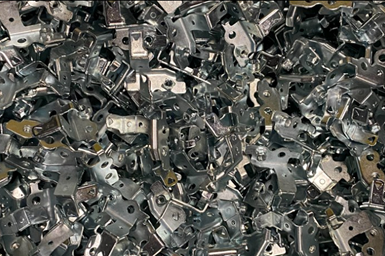Controlling Zinc and Manganese Phosphate Baths
Phosphate baths have become more complex. Understanding some of the key features of these baths and how they can influence finished coating is important.
Share
Read Next

To the uninitiated, the daily operation of a phosphate bath can appear daunting — perhaps even a bit convoluted. While temperature and concentration are common parameters for most chemical applications, zinc and manganese phosphate baths have added complexity acid points, acid ratios, dissolved iron, sludging, heating source and more.
The phosphate coating that develops in these applications is the result of several cyclical competing reactions that occur within the solution and on the surface of the part. Temperature is a key driving force in enabling this reaction to occur, which is why these baths operate at such high temperatures. Typically, a phosphate bath requires a temperature of more than 180°F; the specific operating temp depends on the co-metal and the specific product being used. Running the bath below temp can prevent the reaction from progressing correctly, resulting in a rough, grainy coating or no reaction at all. But if the bath is run too hot, the free acid level will drive up, potentially causing unwanted attack on the base metal.
Achieving and maintaining these temperatures relies on an adequate and reliable heat source; however, not all are created equally in this scenario. One peculiarity of phosphate solutions is that they are sensitive to large temperature gradients, and gradual heating of the solution is preferred. Intense, localized heat sources, such as gas-underfired tanks, disrupt the chemical equilibrium of the solution. This leads to the bath’s parameters deviating from operating range and negatively influencing the coating. Commonly, these baths are heated with immersion steam coils or plates, which heat the solution over a larger surface area and disperse the heat throughout the solution. Other methods include tanks with an insulated jacket heating system that uniformly heats the tank’s surroundings. High volume applications also can use direct, live steam to heat the bath, which, when combined with automatic dosing, can help to compensate for the volume loss due to drag out.
Perhaps the most confusing aspect of phosphate applications would be their total and free acid values. Many chemical applications require a certain concentration for standard operating procedures, which is quickly observed through a simple titration. Phosphate solutions are primarily formulated with phosphoric acid and similarly made up with some prescribed initial concentration. This value is reflected in what is referred to as the “total acid” value or points — this does not necessarily directly translate into a percentage of concentration by volume. Total acid is determined by titrating to a neutral pH, indicated with phenolphthalein, to measure all the contributing components to the solution’s acidity. Adjustments to the total acid value are made by the addition of stock product to the bath.
The “free acid” metric of the phosphate bath solution is what makes it unique. These chemistries are based around phosphoric acid, which has a unique characteristic of being a triprotic acid. In essence, it has three acidic protons (hydrogen ions) in the molecule, and in solution, it exists to varying degrees in four separate states simultaneously. In phosphate applications, this value is the primary constituent to the overall reaction mechanism. If the free acid is too low, the coating will fail to develop; if the free acid is too high, the solution is effectively too reactive and can attack or etch the base metal. The free acid value can be increased by heating the solution without processing work and can be decreased by adding a neutralizing agent to the bath.
The ratio between the values is another nuanced aspect of total and free acid. This is determined by dividing the total acid and free acid values. When a bath is initially made up, the ratio of these components is generally 6-to-1 total acid to free acid. These baths are fluctuating, dynamic systems. As these baths are used and begin to age, the acid values begin to deviate. While different products will curate specific target ranges for these values individually, the ratio between the values is also important as it suggests relative composition of the constituents, independent of the total concentration.
Last, iron concentration is another key component that is monitored in phosphate applications. These reactions can use either zinc or manganese as a co-metal in crystal development. In addition to these co-metals, iron is also fundamental in the formation of these crystals. The recommended iron concentration is specific to the product and application but can range anywhere from 0.0 to 0.4%. Iron levels also have a direct correlation with the resulting coating weight as they add mass to the crystals. Upon initial makeup, the solution will not have any iron dissolved, which is why the baths are often “broken in” with scrap metal or steel wool to dissolve into solution and increase the iron level. Some applications are designed to run iron-free and will use an oxidizing agent or an accelerator to precipitate out the excess iron to achieve low coating weights. Determining the iron level is done with a titration involving permanganate, which is a strong reducing agent.
Understanding the state of your bath and how to manipulate it is an important aspect of successfully operating these applications. Each of the aspects described has a resulting impact on the quality of the coating and serve as key indicators ahead of a successful application.
About the Author
Connor Callais
Connor Callais is an applications specialist for Hubbard-Hall. Visit hubbardhall.com.
Related Content
Possibilities From Electroplating 3D Printed Plastic Parts
Adding layers of nickel or copper to 3D printed polymer can impart desired properties such as electrical conductivity, EMI shielding, abrasion resistance and improved strength — approaching and even exceeding 3D printed metal, according to RePliForm.
Read MoreA Chromium Plating Overview
An overview of decorative and hard chromium electroplating processes.
Read MoreNanotechnology Start-up Develops Gold Plating Replacement
Ag-Nano System LLC introduces a new method of electroplating based on golden silver nanoparticles aimed at replacing gold plating used in electrical circuits.
Read MoreHow to Maximize Nickel Plating Performance
The advantages of boric acid-free nickel plating include allowing manufacturers who utilize nickel plating to keep up the ever-changing regulatory policies and support sustainability efforts.
Read MoreRead Next
Pretreatment of Black Oxide
Having issues achieving a consistent color with the application of black oxide? Start by looking at your pretreatment. Connor Callais of Hubbard-Hall offers advice for troubleshooting your black oxide process.
Read More










.jpg;maxWidth=300;quality=90)







